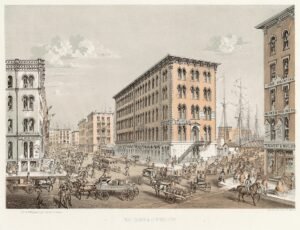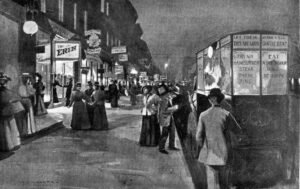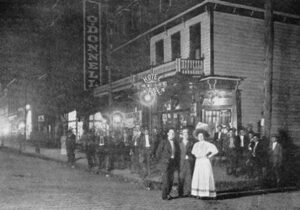Many people flock to red light districts to relax, escape reality, and indulge in their greatest pleasures because they are centres of depravity, sexual vice, and debauchery. Within a few short city blocks were legalized prostitution, drunkenness, and every other vice imaginable. Organized crime, brutality, and vile tales that seem unbelievable but are true come along with it. Since the time of Sodom and Gomorra, and maybe much earlier, red light districts have been the unsavory underbelly of humanity. We present you with the five most notorious former Red Light districts in America.
Many red light districts did not last into the modern era in the United States, a nation formed with strong religious principles opposing sexual activity, especially legalized conduct. Some of the most lascivious, evil, and immoral American red light districts have been listed here, in no particular order. Here are the five most notorious former Red Light districts in America:
1- Cripple Creek, Colorado
Cripple Creek was one of the most notorious former Red Light districts in America. The little Colorado community of Cripple Creek is located just south of Denver. A western town that popped up after a gold rush was soon able to offer “sporting houses” to traveling miners due to an increase in the female population. In the West in the late 1800s, this was typical. Small boom towns like Cripple Creek were frequently transformed into miniature centres of immorality during the American Wild West era, which fueled the already lawless young nation.
The brothels grew in number from Kansas to Texas and even Alaska, and they were as much a part of the wild west as railroad robberies and street gunfights. The brothels, which are often controlled by madams, provided a way out for some working females looking for better opportunities. Two of the prostitutes who worked and resided at these brothels later married renowned gunslingers Doc Holliday and Harry Longbaugh, also known as The Sundance Kid. One woman, Laura Bullion, even joined the Wild Bunch Gang, Longbaugh’s gang
2- Little Cheyenne, Chicago
Just after the Great Fire of 1871, “Little Cheyenne” ruled the area before the Levee District. It was located on the south side of the city’s South Clark Street and embodied the spirit of the Old West, giving its guests access to every possible avenue of immorality. As soon as Cheyenne, Wyoming, heard about it, they gave their prostitution area the nickname “Little Chicago.”
Little Cheyenne operated all the way up until the 1970s. Today, a small portion of it exists in the form of a hotel called the Ewing Annex that rents 5×7-foot (1.5×2.1-meter) rooms to homeless men. These “rooms” are hardly suitable for human inhabitance, separated at times by sheets of chicken wire. This serves as a reminder that the degradation of times past still exists in our modern world.
3- The Levee District, Chicago
Chicago is just one of several American cities that have a reputation for being violent and unlawful. Although other areas had existed for a long time prior, “The Levee District” predominated Chicago’s nightlife from around 1893 through 1912 (although other areas had existed for a long time prior). Since the 1850s, this region on the city’s north bank, along what is now Wells Street, has been a hub for illicit activity.
Bed Bug Row, in the bottom part of the Levee District, was home to some of the filthiest and most repulsive brothels in American history. The Everleigh Club, a 5-star sporting establishment where local women were honored to work, stood in stark contrast. The Levee District contained 46 saloons, 37 “houses of ill-repute,” and 11 pawn shops at its peak in 1894.
In red-light districts like this, the Women’s Temperance Union (WTU) campaigned tenaciously for women’s rights across the country. By October 1911, 135 warrants had been issued for establishments in the Levee District as a result of their victory. Due to the WTU’s heroic efforts on behalf of sex workers, numerous red-light districts across America were shut down.
4- The Tenderloin, San Francisco
One of the most impoverished and violent areas of San Francisco is located just north of Union Square. Since shortly after the devastating San Francisco earthquake of 1906, it has maintained that reputation. Speakeasies, brothels, and other forms of immoral nightlife were in plenty in “the TL” by the 1920s. Police Captain Alexander S. Williams is credited with giving the place its unusual name because the bribes he received there allowed the patrolling cops to purchase a more expensive cut of beef.
Later, jazz and rock ‘n’ roll performers began to congregate there frequently. In the early 1960s, the famed Black Hawk was the location for the live albums by Miles Davis and John Coltrane. Nearby Hyde Street was where the Grateful Dead, Jefferson Aeroplane, and Credence Clearwater Revival made records.
The LGTBQ+ community has used the Tenderloin as a refuge and continues to do so. The Vanguard, one of the country’s first LGBT organizations, called it home. The Tenderloin is San Francisco’s most seedy, drug-filled neighborhood and the centre of the homeless issue, despite no longer being a red-light district.
5 Hell’s Half Acre, Los Angeles
Alameda Street ran alongside the Southern Pacific Railroad and was formerly a popular destination for tourists. It was known as Hell’s Half Acre, and much of it is still a violent part of town today. It was one of the seediest places in California’s history. Women in the neighborhood were said to service 13 to 30 men per day, luring them to their homes by standing on platforms made of wood.
Like in many other red-light districts across the country, police control was incredibly low, and prostitution was rife. Violence against women and drug usage were common occurrences, as well as suicide.
The “father of the cribs,” Barolo Ballerino, was a powerful figure in the neighborhood. His terrible legacy continues to this day, as the neighborhood is still underdeveloped and rife with crime. Due to concerns from women’s rights organizations, these ‘crib houses’ were raided in 1903, and the region ceased to ever again be used as an illegal red-light district.
ALSO READ: Six female teachers arrested for Sexual misconduct with students in US





